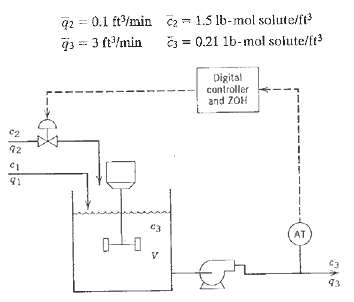The exit composition C3 of the blending system in Fig is controlled using a digital feedback controller.
Question:
The exit composition C3 of the blending system in Fig is controlled using a digital feedback controller. The exit stream is automatically sampled every minute, and the composition measurement is sent from the composition transmitter (AT) to the digital controller. The controller output is sent to the ZOH device before being transmitted to the control valve.(a) Using the information given below, draw a block diagram for the feedback control system. Use the symbols in the figure as much as possible.(b) Derive an expression for the discrete open-loop transfer function C3/Q2, where C3 and Q2 are deviation variables, by deriving the continuous transfer function and then deriving the equivalent discrete time model. The closed-loop system exhibits a first-order response to a unit step change in the disturbance C2. Specify the form of the desired response (C3/C3sp)d. It is not necessary to derive an expression for Gc(z) but you should justify your choice for (C3/C3sp)d.Available Informal Ion(i) Because how rate q2 is quite small, the liquid volume in the tank V remains essentially constant at 30 ft3. The tank is perfectly mixed,(ii) The primary disturbance variable is inlet composition C2.(iii) The control valve has negligible dynamics and a steady-state gain of 0.1 ft3/min mA.(iv) The composition transmitter (AT) has a steady gain of 2.5 mA/(lb-mole solutc/ft3). Composition samples are analyzed every minute; that is, the sampling period is ?t = 1 min. There is also a 1-min time delay associated with the composition analysis.(v) Nominal steady-state values are:
Step by Step Answer:

Process Dynamics And Control
ISBN: 978-0471000778
2nd Edition
Authors: Dale E. Seborg, Thomas F. Edgar, Duncan A. Mellich





